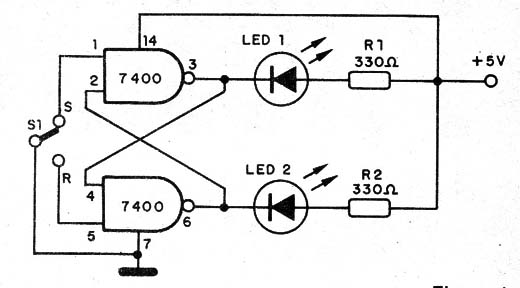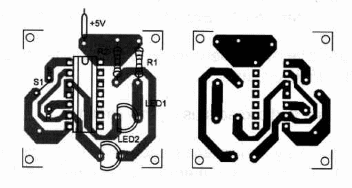With this project we can show how two NAND gates of a 7400 IC (TI'L Integrated Circuit) can be wired to perform as an R-S fIip-flop.
This circuit is a pulse-triggered fIip-flop that needs negative-going pulses to be triggered. This circuit operates as follows: as we see, it hasLtwo outputs; a normal output caHed Q (LED1) and an inverted output called Q (LED2).
When one output is 1 the other necessarüy wiII be 0 and vice-versa because they are complementary.
The circuit has 1also two inputs named S (SET) and R (RESET) as shown in the schematic diagram, where the trigger signals are applied.
R input is wired to Q output and S input is wired to Q/ output, forming a closed- Ioop for the digital signals.
When a negative-going trigger pulse is applied to S input the output Q swings to the 1 state.
As this output is wired to R input, the 1 state causes output Q/ to fall to a 0 leveL But Q output is also wired to S input causing a feedback that makes its output remain at 1 also after the trigger pulse has disappeared.
To trigger the flip-flop again, changing the output states, we should apply a negative-going pulse to R input.This pulse causes the output to go to 1, and as this output is wired to R input, the trigger pulse also causes the output Q to go to 0 IeveI.
A zero in this output goes to R input, and also after the trigger pulse disappears the outputs remain in their states.
See that the circuit has two stable states, and we only can change these states with set or reset (S or R) negative-going pulses applied to its inputs.
Our project is a manuaIIy-triggered fIip-flop and can be óonstructed wiring a switch to the R-S inputs as shown in Figure 1.

Logic states are indicated by two LEDs. LED1 gIows with a 1 at Q output and LED2 glows with a 1 at Q/ output.
The circuit must be powered by a 5~volt regulated power supply as it uses a TTL IC. Current requirements range typically from 5 to 15 mA.
Components placement on a small printed-circuit board is shown in Figure 2.

Experiments like this can also be performed on what electronics experimenters caII “breadboards”.
These are boards on which the parts of experiments can be temporarily assembled. By using breadboards it is not necessary to solder the components.
This is why they are also called “solderless boards”
The circuit can be used to teach much about flip-flops, used in computers as counters and in memories and many other applications.
Observation: ln digital electronics anjelectrical signal is either high or Iow.
These two states are used to represent binary bits 1 and 0. Since digital Iogic
ICs operate from a single-ended power supply, a high state represents a voltage near the supply voltage and a Iow state represents a voltage near 0 V.
SET-RESET FLlP-FLOP
IC1 - 7400 TTL Integrated Circuit
LEDs - Red, green or yellow common LEDs
R1, R2 - 330 ohm, 1/4W, 5% resistors
S1 - SPDT toggle switch
Ideas to Explore
To Iearn more about the circuit and devices:
The common flip-flop ¡s a fundamental counter circuit. Mount other units like this and use them to explain how counters and memories work in computer circuits. Each flip-flop can store a bit.
Find the differences between R-S and J-K fIip-flops and how they are used in Iogic circuits.
Science experiments and projects using this circuit:
- Replace S1 by amagnetic (reed) switch or a microswitch and use
this circuit as a one-event memory in experiments. It can detect and memorize when a switch in an lure, alarm, or mechanical process is closed for a moment.
Obs. This circuit is part of the author’s book Fun Projects for the Experimenter – TAB Books – 1998



